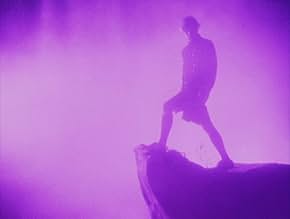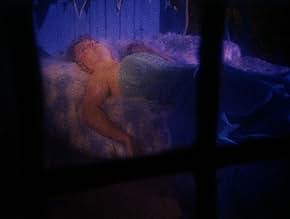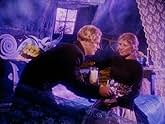The wary residents of a 19th century mountain village must tread carefully and speak softly lest they cause an avalanche. Sexual frenzies teem in this world of repression, setting off incest... Read allThe wary residents of a 19th century mountain village must tread carefully and speak softly lest they cause an avalanche. Sexual frenzies teem in this world of repression, setting off incestuous love triangles with deadly consequences.The wary residents of a 19th century mountain village must tread carefully and speak softly lest they cause an avalanche. Sexual frenzies teem in this world of repression, setting off incestuous love triangles with deadly consequences.
- Awards
- 1 win total
Andrea Von Wichert
- Townsperson
- (as Andrea Wichert)
Featured reviews
If you are a fan of German Expressionism, then you will enjoy this modern homage to a beautiful and arresting style perceived and captured wonderfully by Guy Maddin. There is a ton of symbolism and exploration of the sexual taboos found in both the Oedipus and Cassandra complexes of Greek mythology while allowing for quite humorous character developments which certainly make the film that much more enjoyable than just an "art" film. Maddin's use of light and especially color adds to the classic expressionist model which gets a gorgeous injection of modern fare. While I can enjoy the notion of one reviewer calling this a cross between "The Wizard of Oz and Eraserhead", I definately saw this as a much more direct colorful homage to "Caligari" than anything Lynch-esque. There is not the mind-numbing mixture of light and sound which generates its own tension but rather a playful use of sets and characters which surmount to quite a comical time. That is not to say there is not a scene or two that would make a horror fan happy but they are very straight forward and even amusing.
I really like Maddin. I like the way he thinks visually first. Narrative is not only woven into and communicated by cinematic means, but his characters live in a similar world. They experience the world, the same way we experience the film: by what some call a surrealistic dream world. It is not. Rather it is a world wholly driven by laws, laws we understand because they are rooted in film worlds we have visited.
I have two of his films on my "must experience before you die" list. This one is narratively less subtle and powerful than those. He makes a trade-off by investing in what is often - including here - called "German Expressionism." Actually, the model is German mountain films, a quite different beast: one that is more genuinely pre-noir.
The world behind those films has a people in tune with a nature that limits their lives, often controlling. American noir would later merge this collection of laws with the narrative conventions built into the act of viewing. What this film does is insert itself before that development. It is pre-noir tragedy with noir-like conventions, cast using those German pre- noir images.
It is a stretch to merge German notions of superior harmony with the mountain homeland with the Nazi comfort with the cruelty of nature. But heck, others do; there is the tradition of Riefenstahl's mountain films and then her similarly inspired Nazi propaganda; and after all, films like this encourage such stretches. And a similar stretch goes in the "White Ribbon" direction, with nature and its German bond with sexual repression behind what happened. Herzog continues this even today.But all that is predicable and easy to read, compared to Maddin's deeper stuff.
Ted's Evaluation -- 3 of 3: Worth watching.
I have two of his films on my "must experience before you die" list. This one is narratively less subtle and powerful than those. He makes a trade-off by investing in what is often - including here - called "German Expressionism." Actually, the model is German mountain films, a quite different beast: one that is more genuinely pre-noir.
The world behind those films has a people in tune with a nature that limits their lives, often controlling. American noir would later merge this collection of laws with the narrative conventions built into the act of viewing. What this film does is insert itself before that development. It is pre-noir tragedy with noir-like conventions, cast using those German pre- noir images.
It is a stretch to merge German notions of superior harmony with the mountain homeland with the Nazi comfort with the cruelty of nature. But heck, others do; there is the tradition of Riefenstahl's mountain films and then her similarly inspired Nazi propaganda; and after all, films like this encourage such stretches. And a similar stretch goes in the "White Ribbon" direction, with nature and its German bond with sexual repression behind what happened. Herzog continues this even today.But all that is predicable and easy to read, compared to Maddin's deeper stuff.
Ted's Evaluation -- 3 of 3: Worth watching.
The USA Film Festival described this as Twin Peaks directed by Erich von Stroheim. Not a bad description. It's an uproarious satire, in the vein of YOUNG FRANKENSTEIN ... but the film often so beautifully duplicates the material it parodies that your breath is taken away. It's a little like reading a hysterical comic book, and finding original paintings by old masters salted throughout!
This brilliant Canadian film heavily borrows from the high-camp expressionism of German silent films and early talkies, especially the "mountain" films of Leni Riefenstahl. Anyone who's read FROM CALIGARI TO HITLER will recognize dozens of scenes in this film as near carbons of stills from the book. Perhaps more than any other films before or since, German silent cinema created compelling images that tap into universal race consciousness, portraying grainy, moving archetypal images all of us vaguely recognize from dreams or nightmares. Because of this, CAREFUL will often take your breath away with unexpected moments of quiet majesty and beauty. But there are plenty of laughs in between, (with "sick," 70's style National Lampoon-like humor). If you've never laughed at seeing an eye poked out, leave political correctness at the door and give this film a whirl!
The soundtrack if often deliberately scratchy or muffled, and in several scenes easter-egg like colors are used that resemble the early two-strip technicolor process. Ominous title cards are used to introduce scenes. This bizarre film is salted with unexpected dialogue like this: BOY: "My, aren't you the frisky one today." GIRL: "Even the reindeer are such, when Spring is coming!"
Enough of the aesthetics, what is the film supposedly about? The action takes place in the 19th century alpine village of Tolzbad, that is so precariously poised under constant threat of avalanche that villagers have learned to communicate only in whispers. Animals have had their vocal chords removed, and gramophones have lambs wool stuffed in the horn. Villagers keep time to the "sound" of silent instruments at a "concert." There are handful of soundproof ice caves where the villagers can frolic and shout, letting out their pent up, pagan passions. The film is clearly a biblical parable about repression. Jackie Burroughs does a brilliant bit part as the puritanical teacher, who closely resembles the Cloris Leachman role in YOUNG FRANKENSTEIN.
All of the characters display a surface naivete; actresses speak in the perky, breathless voices reminiscent of badly dubbed post-war European B films; "strapping" young sons still wear short pants'd school uniforms. The film quickly descends below the surface to show the village as a cauldron of incestuous flirtations, violent retaliation and explosive "family secrets." The plot follows an arc of forbidden loves and passions, leading to retribution on a biblical scale. What may appear to the modern audience as "cheap" special effects are actually loving recreations of how ghosts and visions were portrayed in silent and early talking German films. Many of the images are unforgettable, like the "trolley" cars pulled by oxen, or the mine workers wearing crowns of flickering candles. Uncoated lenses and back lit hair make some closeups resemble images from early Garbo or Dietrich films.
CAREFUL warrants multiple viewings. Watch it with a friend; this is definitely a film you'll want to dissect over several capuccinos.
This brilliant Canadian film heavily borrows from the high-camp expressionism of German silent films and early talkies, especially the "mountain" films of Leni Riefenstahl. Anyone who's read FROM CALIGARI TO HITLER will recognize dozens of scenes in this film as near carbons of stills from the book. Perhaps more than any other films before or since, German silent cinema created compelling images that tap into universal race consciousness, portraying grainy, moving archetypal images all of us vaguely recognize from dreams or nightmares. Because of this, CAREFUL will often take your breath away with unexpected moments of quiet majesty and beauty. But there are plenty of laughs in between, (with "sick," 70's style National Lampoon-like humor). If you've never laughed at seeing an eye poked out, leave political correctness at the door and give this film a whirl!
The soundtrack if often deliberately scratchy or muffled, and in several scenes easter-egg like colors are used that resemble the early two-strip technicolor process. Ominous title cards are used to introduce scenes. This bizarre film is salted with unexpected dialogue like this: BOY: "My, aren't you the frisky one today." GIRL: "Even the reindeer are such, when Spring is coming!"
Enough of the aesthetics, what is the film supposedly about? The action takes place in the 19th century alpine village of Tolzbad, that is so precariously poised under constant threat of avalanche that villagers have learned to communicate only in whispers. Animals have had their vocal chords removed, and gramophones have lambs wool stuffed in the horn. Villagers keep time to the "sound" of silent instruments at a "concert." There are handful of soundproof ice caves where the villagers can frolic and shout, letting out their pent up, pagan passions. The film is clearly a biblical parable about repression. Jackie Burroughs does a brilliant bit part as the puritanical teacher, who closely resembles the Cloris Leachman role in YOUNG FRANKENSTEIN.
All of the characters display a surface naivete; actresses speak in the perky, breathless voices reminiscent of badly dubbed post-war European B films; "strapping" young sons still wear short pants'd school uniforms. The film quickly descends below the surface to show the village as a cauldron of incestuous flirtations, violent retaliation and explosive "family secrets." The plot follows an arc of forbidden loves and passions, leading to retribution on a biblical scale. What may appear to the modern audience as "cheap" special effects are actually loving recreations of how ghosts and visions were portrayed in silent and early talking German films. Many of the images are unforgettable, like the "trolley" cars pulled by oxen, or the mine workers wearing crowns of flickering candles. Uncoated lenses and back lit hair make some closeups resemble images from early Garbo or Dietrich films.
CAREFUL warrants multiple viewings. Watch it with a friend; this is definitely a film you'll want to dissect over several capuccinos.
I recently watched the film, Careful, by Guy Maddin on television and found it to be very interesting indeed. The person introducing the film called Maddin a Canadian David Lynch and while both directors do have a certain flair for the unusual, I believe Lynch to be a surrealist while Maddin's style to be something else entirely. Granted, Careful is the only film of Maddin's I have seen except for excerpts and press for The Saddest Music in the World, but his style, at least in this film, is one of sentimentality and homage. I have seen plenty of German Expressionist films and Careful would seem to fit right into that mold. I myself have often toyed with the idea of producing a film in the Expressionist style if only for the exercise of it. Maddin has produced an Expressionist film in the year 1992 which flawlessly mimics the films of Ufa, Wiene, Murnau, and Lang from the early 20th century. Any viewer, even those versed in early Expressionism, who would happen across this film without any context would be forgiven for mistaking it to be an actual 80-year-old film, so true is Maddin's style, so exacting is his pacing. Full frame color tinting, sound stage shooting, post-produced soundtrack, rigid acting style, and obsolete directorial choices, combine to provide the viewer with a disturbing portrait of repression, duty, and mountain goats. This film is incredible!
Will wonders never cease? Here is a DVD that I never thought I'd see. Guy Maddin's brilliant and hilarious (particularly for early film buffs) `Careful.' The plot and style of this film have been well explained by other commentaries on this page and elsewhere, so there's no need to go over it again. My favorite comment about it is that it is like a Ricola ad gone horribly, horribly wrong. Suffice it to say that the DVD is an improvement in image quality. While many of the images are intentionally vague, grainy or indistinct by the choice of the filmmakers, I get the impression that these effects are more clearly conveyed in the DVD. In a spoken commentary track with Maddin and screenwriter George Toles (new to this DVD, and obviously not possible on the VHS edition), Maddin admits that he wanted to add an effect through use of the color controls during the digital transfer, but resisted that temptation in order to let this DVD stand as a faithful representation of the film. While the effect he had in mind might have been interesting, I'm still grateful to him for his restraint.
Maddin claims in his commentary that people often obliquely criticize the performances of the actors in this film while, at the same time, telling him how much they like it, placing him in the position of defending those performances. Maddin states that he absolutely stands by the performances in this film, and that the actors gave him precisely what he asked for. This should dispel any doubts among people who see this film about the unusual, stiff delivery of lines, which might lead people who know nothing about the cast to suspect they are amateurs, which they are definitely not. This sort of line reading can be seen in some of the very earliest talkies. The antiquated sound of this film, along with its look, is all of a piece, and completely intentional, right down to the fake patina of noise added to the mono soundtrack. Maddin does regret some of the props and effects which had to be done on the cheap, due to budget restraints. Who knows how much more bizarre and fantastic it might have looked with a larger budget? On the other hand, it might have lost some of its unique charm. As it is, it's a wonderful piece of work that I find unforgettable, and that has remained vivid in my memory years after first seeing it. Copies of this DVD aren't to be found in abundance, and I don't know how long it will stay in print. If you like this film, do get this DVD now, and tell anyone you know who likes unusual films about it.
Near the end of the film, which hints at a continuation of the story, Maddin says that he may make that sequel some day. I don't know if he was serious about it or not, but I'd sure love to see it.
Maddin claims in his commentary that people often obliquely criticize the performances of the actors in this film while, at the same time, telling him how much they like it, placing him in the position of defending those performances. Maddin states that he absolutely stands by the performances in this film, and that the actors gave him precisely what he asked for. This should dispel any doubts among people who see this film about the unusual, stiff delivery of lines, which might lead people who know nothing about the cast to suspect they are amateurs, which they are definitely not. This sort of line reading can be seen in some of the very earliest talkies. The antiquated sound of this film, along with its look, is all of a piece, and completely intentional, right down to the fake patina of noise added to the mono soundtrack. Maddin does regret some of the props and effects which had to be done on the cheap, due to budget restraints. Who knows how much more bizarre and fantastic it might have looked with a larger budget? On the other hand, it might have lost some of its unique charm. As it is, it's a wonderful piece of work that I find unforgettable, and that has remained vivid in my memory years after first seeing it. Copies of this DVD aren't to be found in abundance, and I don't know how long it will stay in print. If you like this film, do get this DVD now, and tell anyone you know who likes unusual films about it.
Near the end of the film, which hints at a continuation of the story, Maddin says that he may make that sequel some day. I don't know if he was serious about it or not, but I'd sure love to see it.
Did you know
- TriviaRebecca Gibson's debut.
- ConnectionsFeatured in Guy Maddin: En attendant le crépuscule (1997)
- How long is Careful?Powered by Alexa
Details
Contribute to this page
Suggest an edit or add missing content

























